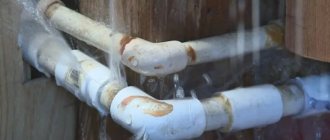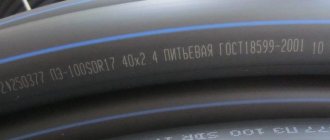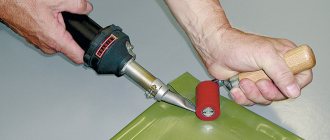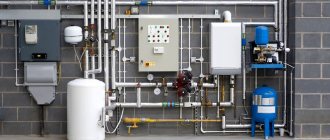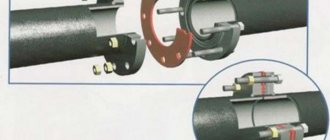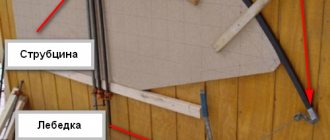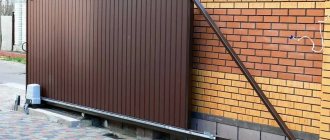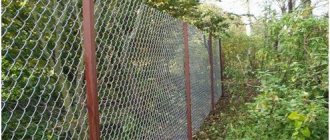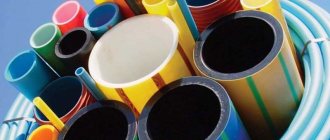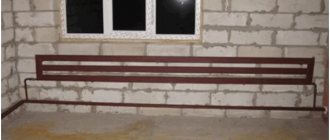Pipes made from a symbiosis of metal and plastic are produced for the construction of intra-house highways. The new products made it possible to assemble a water supply and heating system yourself, without involving plumbers. Pipelines serve for a long time, are installed extremely simply and quickly, without creating problems even for inexperienced craftsmen.
By installing metal-plastic pipes yourself, you can save a lot of money, preserving the family budget for more important expenses. To install them, a home craftsman only needs to stock up on an easy-to-use tool, patience and knowledge, which we are ready to share with site visitors.
We will tell you everything about the specifics of using metal-plastic products and methods of connecting pipelines assembled from them. The article describes in detail the negative and positive aspects of their use. Here you will learn how to install trouble-free systems.
Features of metal-plastic products
Metal-plastic (metal-polymer pipes) are composite products for the production of which various types of materials are used. Such elements have an attractive appearance, good wear resistance, elasticity, and strength.
Metal-plastic pipes are distinguished by high consumer qualities (strength, flexibility, resistance to high temperatures and aggressive substances), as well as an aesthetic appearance
Typically, a pipe consists of five layers. A durable polymer, usually cross-linked polyethylene, is used as a supporting base. It makes the inner surface smooth, protecting it from blockages, and also contributes to the strength of the product.
An adhesive is applied to the core, on which aluminum foil that stabilizes the pipe is attached (it also prevents the ingress of oxygen). The connection is secured by butt or overlap welding.
The design of a metal-plastic pipe involves the use of five layers of different materials: two layers of polyethylene, two layers of glue, a layer of aluminum foil
The fourth layer is also applied with glue, to which the outer covering is connected - white polyethylene, which provides protection to the product and gives it an aesthetic appearance.
Non-standard connection options
It may be necessary to connect metal-plastic parts of communications with pipes made of a different material or switch to a different diameter.
For this purpose, special fittings are used. Both compression and press adapters are available for sale.
For connection, it is necessary to select the correct adapter of the appropriate diameter with internal thread. In this case, the external thread is cut on the pipe itself. To make the joint more durable, various sealants are used: flax fibers, fum tape or special paste.
Technical characteristics of pipes D 16-20 mm
Here are the data typical for metal-plastic pipes of common diameters (16 and 20 mm):
- The wall thickness is 2 and 2.25 millimeters, respectively; The thickness of the aluminum layer is 0.2 and 0.24 mm.
- One running meter weighs 115 and 170 grams and holds a volume of liquid equal to 1.113 and 0.201 liters.
- The thermal conductivity coefficient is 0.43 W/m K, the expansion rate of metal-plastic is 0.26x104 per 1 degree Celsius, the roughness coefficient is 0.07.
- When the material breaks transversely, the strength coefficient is 2880 N.
- The strength of the connection between the adhesive layer and the foil is 70 N/10 sq. mm, the strength coefficient of the aluminum welded layer is 57 N/sq. mm.
- Metal-plastic pipes can operate even at +95o C, briefly withstanding temperatures of +110-130o C.
- Within the temperature range from 0 to +25o C, the system operates at a pressure of up to 25 bar, and at +95o C it can withstand a pressure of 10 bar.
- The tightness and integrity of the metal-plastic pipe is broken under a load of 94 bar (at +20° C).
With proper installation and compliance with operating rules, products made of metal-polymers can last 50 years or more.
Application area
Due to the technical characteristics of metal-plastic, the material has found application in pipelines for cold and hot water supply, as well as sewage.
It is used for various heating systems:
- Underfloor heating device "warm floor".
- Connection to wall-mounted radiator radiators.
- Heating of soil in closed greenhouse complexes and greenhouses.
- Water heating device for swimming pools.
- Laying protective screens for power cables.
- Compressed air supply.
Metal-plastic products can be found in air conditioning systems and in transport routes for the movement of gaseous and liquid substances.
Areas of application of metal-plastic elements
Pipes made of metal polymers are widely used in the construction of individual houses, in industrial construction and agriculture.
The main areas of their use are:
- transportation of liquids, gaseous agents;
- laying drainage systems, water pipes, heating;
- in structures involving the transfer of compressed air;
- supplying heating components to radiators, installing heated floors;
- installation of air conditioning circuits;
- protection and shielding of wires (primarily power);
- construction of irrigation systems.
Metal-plastic is not recommended for use:
- when organizing central heating systems with the proposed construction of elevator units;
- in places with an assigned fire safety level “G”;
- with the expected supply of hot liquid in the pipeline with a working pressure >10 bar;
- in rooms where it is planned to place sources of thermal radiation with a surface temperature of over 150 degrees C.
In addition, it is undesirable to use metal-polymer pipes in safety, signal, overflow, expansion circuits and in fire-fighting water supply systems.
Metal-plastic products are widely used in private and industrial construction. This photo shows pipes used for laying heating systems
Fittings for connecting metal-plastic pipes
- With crimp fastening method. Used for assembling pipelines with unobstructed access. It is important to realize that it is necessary to tighten the created connections.
- Press models. They differ in that they can be walled up.
To make the right choice, you need to be aware of the type of upcoming installation for a specific part of the heating system.
Three main methods of pipe routing
The wiring of metal-plastic systems can be carried out using different methods, each of which is selected based on the feasibility and possibilities of further access to the system.
Option #1: hidden
In this case, all pipes and connections are hidden deep in the wall under the finishing materials. Only fittings and bends for connecting plumbing fixtures are exposed outside.
The hidden installation method involves installing the structure in the wall, where recesses are specially prepared for pipes, after which the surface is sealed
When using this installation method, the interior design is preserved, in addition, masking communications protects them from accidental damage.
This option has several disadvantages:
- Laying channels for pipes requires a complex and labor-intensive gating process. After laying communications, the surface must be restored again.
- This method is not suitable for load-bearing walls, where gating is prohibited by regulatory documents.
- Quite a high cost associated with additional work.
This method is best used when renovating a bathroom. It is not advisable to install a hidden installation in an already decorated room, since this will require complete dismantling of the wall covering (cladding, plaster).
Option #2: open
If for some reason the pipes cannot be hidden in the wall, they can be laid along its surface. This option is more convenient for visual inspection of joints, which allows, if necessary, to quickly clean the area or replace a component.
With the open method, pipes are laid along the surface of the wall, which allows for control of connections and reduces the cost of work
Open wiring can be used in rooms that have already been renovated, since the installation will not harm the design of the walls. The advantages of this method include its ease and lower cost of work than when laying internal communications.
Option #3: combined
In this case, the pipes are laid along the surface of the unfinished walls, after which they are covered with boxes or false panels. This is a rather complex method, since it requires the perfect fit of decorative elements into the interior, which can also be used as drywall, tiles and other materials.
Learning how to install with compression fittings
It is worth noting that compression fittings are more reliable and are used much more often. They have a complex structure.
Arrangement of compression fittings
- The base is made in the form of a cast body with the addition of threads;
- To fasten and fix the pipe pieces, a ferrule ring and a union nut are used to secure the connection;
- O-rings guarantee a high level of tightness.
This installation option does not require any special equipment. The connection is simple and quickly disassembled, so replacement of the fitting is allowed.
Unfortunately, leaks sometimes appear on the threads. This can be eliminated by tightening the connection. Therefore, you cannot wall up the pipe along its entire length. Not everyone likes the need to check for water leaks, but in general this option is very reliable and not expensive.
Installation process
- It is necessary to remove the union nut with the crimp fastener. Next, you should make sure that the rubber seal is reliable or actually present. Now let's move on to the main assembly;
- The nut together with the ring must be put on the pipe;
- A piece of metal-plastic pipe is put on the fitting until it stops, we are talking about reaching a special protrusion;
- The ring is placed all the way onto the fitting itself;
- It is necessary to tighten the union nut. The connection of metal-plastic pipes is tightened by hand, thanks to two keys. One is needed to hold the fitting body and the other to tighten the union nut.
The installation of the fitting is actually complete. But in case of antifreeze flooding, it is worth using other gaskets. It is necessary to use Teflon or paronite. Otherwise, a leak will appear very quickly.
Wiring diagrams for bathrooms and bathrooms
For plumbing work carried out in bathrooms and toilets, three layouts of metal-plastic pipes can be used. For private houses, the most rational option is to use a collector.
Efficient collector system
A reliable and practical option that involves connecting each object to a central pipe through a supply pair. This allows the faucet to regulate or turn off the water supply to each specific plumbing fixture.
With parallel wiring, each plumbing fixture is equipped with its own water line and its own shut-off valve. All branches come out of one device - the collector
All control devices are located in a compact manifold, which is placed in a space specially designated for them (cabinet).
Supply pipes with a minimum of connections do not require special control, which allows for hidden installation. The disadvantage of this option is the rather high cost, since for each connection you will need to purchase a special shut-off valve. Since such a system is quite complex, work must be done carefully and carefully.
In collector water distribution, control devices and shut-off devices are installed on the pipe supplying water to the collector
An important advantage: if a separate item (washing machine, faucet) fails, there is no need to completely disconnect the bathroom from the water supply - just turn off the necessary shut-off valve.
Serial connection system
This option involves connecting each plumbing item to the main pipe using a separate tee. It is more suitable for bathrooms with a minimum number of objects (washing machine, common faucet).
Sequential wiring, shown schematically in the figure, is recommended for use in rooms with a small number of objects that are alternately connected to pipes using tees
A sequential scheme can be implemented after finishing work has been completed in the room, using an open laying system. The assembly process is quite simple: the pipe is laid from one object to another, and at the same time the supply element is removed from the tee.
This option requires minimal financial costs. It should be taken into account that if there are a large number of liquid intake points, the pressure may not be enough, and the system will function with difficulty or even fail completely.
Wiring system with pass-through sockets
The connection of plumbing fixtures is similar to the serial one, but instead of tees, sockets are used. This scheme is usually used only in individual houses, since it requires laying long pipes, as well as installing an additional pump that will help provide the required water pressure.
When performing connecting work with metal-plastic pipes, several important nuances should be taken into account:
- When developing a design, it is desirable to provide a minimum of connections.
- It is important to use pipe and couplings made from the same material.
- It is better to use thermal insulation for the pipeline to prevent condensation from settling.
- It is necessary to provide free access to metering devices, filters, and detachable connections.
Compliance with the rules will allow you to create a reliable system that can last for many years.
Heating systems: their types and installation rules
Before installing a heating system in a house, you should first decide how the coolant (in most cases it is water or non-freezing antifreeze liquid) will circulate through it. Because both the choice of heating boiler and the choice of pipes directly depend on this step.
At the moment, there are the following types of boilers used for heating private houses:
- gas - one of the most popular, powered by natural gas;
- solid fuel - also very popular, can run on various types of solid fuel (coal, firewood, peat);
- liquid fuel (diesel) – less popular compared to others and run on liquid fuel (usually diesel fuel);
- electric - optimal in conditions of lack of gas, because they run on electricity;
- combined ones are universal and can operate on different types of fuel.
As a rule, the following option for dividing heating systems is generally accepted:
- with natural circulation, in which the coolant moves due to the temperature difference: hot water rises and, gradually cooling, naturally falls down;
- with forced circulation, in which the movement of the coolant occurs due to the connected circulation pump.
The first option allows the heating system to operate only using a gas boiler, without additional installations. But, at the same time, its installation will require complex calculations, calculation and compliance with the required slopes and a strictly defined distance between the pipes.
In this regard, a forced circulation heating system has a number of advantages and is considered more efficient. A pump installed separately or built into the boiler provides the necessary pressure in the system, regardless of the presence or absence of a slope or the length of communications. Even in this case, you can install heating pipes of small diameter, which provides additional opportunities for interior design.
The pressure created in a heating system with natural circulation is usually 1.5 - 2 bar, and in a system with forced circulation - 2 - 4 bar.
Its main advantages include the absence of high temperatures and pressure, as well as the possibility of using thin metal or flexible corrugated foil pipes. But despite this, this system also has disadvantages. So, due to the strong noise and overall dimensions of such pipes, installation and installation in the wall may not always be possible.
After you have been able to decide on the type of heating system to be installed and choose the most suitable option, you should familiarize yourself with some points that are important to consider when installing it.
So, the rules for installing heating systems are as follows:
It is necessary to maintain the recommended distance between communications and not install additional objects (shut-off valves, strainer) between the boiler and the safety group (pressure gauge, relief valve, automatic air vent). In a network with a forced heating system, a strainer can be installed in front of the pump. Pipes should be selected based on the type of boiler. Different types of pipes can be combined, but you must carefully study their markings and manufacturer’s recommendations. When connecting a large number of radiators, double-circuit wiring should be done and large-diameter pipes should be installed. It is important to provide for the installation and removal of combustion products to the outside if required by the boiler design.
Now we will tell you in detail about what types of heating pipes there are, what main characteristics and properties they have.
Layout of sewer pipes
The work of installing sewer metal-plastic pipes has its own characteristics.
Sewer distribution made of metal-plastic has a number of features. In this case, it is important to use pipes of larger diameter, and also take measures to organize the slope of the pipeline
In this case, to ensure smooth drainage of wastewater and prevent blockages, it is important to comply with the following requirements:
- Maintain a slope (0.02-0.03 of the entire length of the structure) towards the drain manifold.
- It is prohibited to install bends at an angle of 90 degrees when installing structures.
- The need to install special tees with removable covers (revisions) in areas before turns that are prone to blockages.
- When installing the system in a hidden way, it is important to leave viewing windows opposite the revision.
- When assembling a system, it is important to leave a reserve intended for thermal expansion of the product.
For sewer installation, it is necessary to use pipes whose diameter ensures easy passage of wastewater.
For toilets, it is recommended to use products with a diameter of at least 100 mm; for bathtubs and sinks, 50-75 mm is sufficient.
How to bend a metal-plastic pipe?
Metal polymer is a flexible material that can be easily deformed by hand. However, in order to bend them without damaging the inner layer, without reducing the throughput, the following devices should be used:
- Spring. Special springs for bending metal-plastic can be purchased according to the diameter of the selected material. It is inserted into the place of the intended bend and then worked with your hands.
- Sand. If you fill a pipe with sand, it, like a spring, will prevent the inner layers from deforming. The main condition is that the sand must fill the entire volume tightly.
- Crossbow pipe bender. It is used according to the instructions.
- Construction hairdryer. Use a hairdryer to heat the material before bending it with your hands. Temperature makes plastic and metal more malleable, which prevents possible damage.
The arm bending technique is as follows:
- The thumbs of both hands are placed point-blank at the bottom in the center of the intended bend. They create tough resistance.
- The remaining fingers are placed wide apart and gently press down on the pipe.
Craftsmen, as a rule, make small bends in small-diameter pipes without the use of special devices. However, for this you need to have extensive work experience and feel the material.
Rules for installation of metal-polymer structures
When laying metal-plastic systems, it is important to be guided by the following provisions:
- When laying hidden pipelines from this material, it is important to provide removable shields (hatches) that are free of sharp protrusions. They provide access to compression fittings.
- It is important to lay systems through building structures using sleeves whose internal diameter is 0.5-1 cm larger than that of the pipe. The gap that forms between the elements must be filled with soft, non-flammable material that allows the pipe to move in the longitudinal direction.
- When laying metal-plastic plumbing or heating systems, it is important to avoid damage to the surface of the elements, including scratches or cuts. To unpack the bay, it is better to avoid sharp objects and mark the structure with a pencil or marker.
- Installation of the structure can be carried out using a support or suspension, which are usually present in the range of manufacturers of metal-polymer pipes. They help to attach products to the wall, while metal parts are installed with spacers made of soft material.
All stages of operations must be carried out carefully and carefully, since metal-plastic elements are sensitive to ultraviolet radiation and mechanical damage. External installation of such structures is appropriate only in places where there are no such factors.
How to attach metal-plastic pipes to walls?
To secure a pipeline made of metal-polymers, there are special plastic clips or brackets. Select fasteners according to the diameter of the pipe. They are attached to the walls where communications are laid.
We recommend that you read: How to make the transition when replacing pipes from metal to polypropylene?
The distance between the fasteners is 1 meter. At the same time, in places of bending, fastenings are made on both sides.
Tools and materials for laying pipes
Laying metal-polymer systems requires a minimum of devices and materials, but it is better to choose high-quality devices and pipes.
Pipeline installation accessories
To create a structure made of metal-plastic, a very modest set of tools is enough: a pipe cutter, a simple pipe bender, press pliers, a sliding and spanner wrench.
To install a metal-plastic system with your own hands, you need a minimum of tools, which can be purchased in a set or separately from a construction supermarket.
To separate measured sections of pipe from the coil, it is advisable to stock up on a pipe cutter designed for cutting metal-plastic pipes. Since metal-plastic is a fairly malleable material, it can be cut with a hacksaw or even a sharp knife.
However, ideal perpendicularity of the lines, without which it is difficult to obtain a tight connection, can only be achieved by using a special cutter.
Different types of wrenches are important for installing and assembling threaded connections on pipeline fittings. If absolutely necessary, you can get by with one spanner, but for comfortable work it is better to use two spanners and one adjustable wrench.
A gauge is an important tool for creating an accurate and tight connection between a pipe and a fitting: it allows you to center the cut plane and chamfer the inside of the product.
The pipe bender allows you to change the configuration of the element, so you can save on corner fittings. It is especially important to have this tool if the design involves a large number of angular mates.
Before starting work, we advise you to familiarize yourself with the rules and specifics of crimping metal-plastic pipes.
What materials will be needed?
To lay the pipeline, it is important to stock up on the following components:
- pipes (coils, measured sections);
- various fitting options (bends, tees, corners), with the help of which individual sections of pipes are transformed into a single system;
- fastening elements - dismountable clamps and clips, with the help of which metal-plastic structures are fixed to supporting surfaces, most often on the wall.
It is important to select all the necessary materials and tools in advance so that you can carry out all the work smoothly.
This article will introduce you to the range of metal-plastic products for pipeline assembly.
Installation tool
Special tools will be needed to install metal-plastic pipes using press fittings. It is designed for cutting pipe sections of the required length, shaping them to round ends and the required internal diameter, and pressing the fitting sleeve onto the pipe.
Press jaws
Pressing pliers are required to compress the liner onto the outer pipe casing. Their working surface has a shaped shape, which allows you to effectively compress the sleeve with the best coefficient of adhesion.
It is worth noting that thin-walled metal pipes made of steel with a protective coating, stainless steel and copper are also mounted by pressing. In our country they are not so widely used due to the too high cost of pipes and fittings, as well as the most professional crimping tools.
Therefore, many modern pressing pliers are produced with replaceable nozzles for metal-plastic, as well as thin-walled copper and stainless steel pipes, produced according to different production technologies and standards in the USA, Canada, and Australia.
Rice. 9 Manual press jaws and their equipment
Article on the topic:
Press pliers for metal-plastic pipes - types, models, how to use. When installing metal-plastic pipes, it may be useful to read about the types and popular brands of press pliers, as well as the technology for crimping pipes with hand pliers!
Manual
Hand-held mechanical tools in the form of pliers with long handles, which can be extended in many models to create a more powerful clamping force, are produced with interchangeable attachments in sizes 16, 20, 26, and 32 mm. It is worth noting that most hand-held work tools do not work with the 32 mm size due to the excessive physical effort that must be exerted by the worker for crimping.
Also, hand tools are designed only for working with metal-plastic; for metals, a more powerful hydraulic or electric drive is required.
It is worth noting that it is rational to use hand tools in cases where a one-time installation of metal-plastic pipes is carried out with your own hands. It is unsuitable for professional purposes due to too high energy losses by the worker.
The disadvantages of hand pliers include their high overall dimensions due to long handles, which is not always convenient when working in confined spaces.
The cost of the instrument itself can vary significantly from one manufacturer to another by almost an order of magnitude; inexpensive models of average quality can be purchased for around 10,000 - 20,000 rubles.
Rice. 10 Hydraulic crimping tool
Hydraulic manual
The hydraulic hand tool is equipped with a hydraulic drive, due to which the clamping force it develops is much higher than that of its manual counterparts.
Using a hand-held hydraulic tool, you can crimp pipes with diameters of 16, 20, 26 and 32 mm, both from metal plastic and from thin-walled stainless steel and copper.
Thanks to its small size and short handles, hand-held hydraulic tools can be used to crimp in hard-to-reach places. This tool is perfect for both home use and professional use.
Although hydraulic pliers are more expensive than manual pliers, if you approach their purchase wisely and order goods from China on the Aliexpress resource, you can easily spend 10,000 rubles.
Pipe line marking
Before starting work, it is important to think about how the pipes will be placed.
When developing a scheme, it is advisable to:
- Draw pipeline lines directly on the walls of the room where it is planned to be laid, which helps visualize the structure.
- As a starting point, use the connection point of the pipe to the tap or radiator, which must already be installed before installation begins.
- Minimize the number of tees and crosses that affect pressure stability, and also minimize the number of other fittings.
- For corner laying of metal-plastic pipes, you can use a pipe bender or corner fittings.
- All connecting elements should be provided with free access, since threaded fasteners need periodic tightening to avoid leaks.
The installation of connecting elements must be carried out after completion of calculations and marking of the structure.
Preparation for installation
Before installing a water supply system, you must carefully consider its layout and location. First of all, it is worth noting on the plan all points of water consumption (faucets, shower, washing machine and dishwasher), relative to their location in the house.
Water supply in the apartment. Replacing metal-plastic pipes with polypropylene for soldering
Then you need to connect these points with lines indicating pipes, and you need to note their diameter, the direction of water flow, and also divide them into those intended for hot and cold water. Calculate the approximate footage of the resulting diagram.
It is necessary to buy pipes with a reserve of at least 10 meters, since when installing them yourself, losses during assembly are inevitable. If they still remain, they can always be used during repairs or connecting new equipment.
After this, it is necessary to mark on the diagram all the connection points, as well as those places where the locking devices will be installed.
Safety valves must be installed at the entrance to the house in front of the meter, as well as in front of each consumption device.
See how to install a polypropylene water supply with your own hands.
Having done this, you will find out the number of installation units required to assemble the water supply system and their specifications. An approximate calculation process is shown in the video.
Conclusions and useful video on the topic
In the video below, plumbers will tell you how to correctly and quickly install structures made of metal-plastic pipes:
Using the right methods and quality components allows you to create durable metal-plastic systems that will last for a long time without leaks, repairs or unnecessary material waste.
You can talk about how you installed and connected metal-plastic pipes in the block below. Please comment on the information we provide. Ask questions, share useful information and thematic photographs.
